https://shar.es/1BxvLe
Some of the finest botanical and zoological paintings in the world are going on display at the Weston Library.
Painting by numbers, a new display running from 29 April to 9 July, brings together beautiful watercolours and field sketches by the celebrated central European botanical artist, Ferdinand Bauer (1760-1826), including incredible paintings of marine animals which have never been displayed before.  The display focuses on Bauer's ground-breaking two-year expedition to the eastern Mediterranean with John Sibthorp (1758-96), Sherardian Professor of Botany at Oxford, and the current research by the Bodleian Libraries Heritage Science team to unravel Bauer's painting by numbers system.
The display focuses on Bauer's ground-breaking two-year expedition to the eastern Mediterranean with John Sibthorp (1758-96), Sherardian Professor of Botany at Oxford, and the current research by the Bodleian Libraries Heritage Science team to unravel Bauer's painting by numbers system.
The numerical notes on Bauer's botanical sketches indicate that he assigned different colours different numbers, and marked these numbers on his sketches, so when he later turned these into more detailed watercolours, he would know which colour to use where. This enabled him to replicate his sketches of flora and fauna to an amazing degree of accuracy, but researchers are still trying to understand exactly how this worked in practise, and if he used a colour chart that has since been lost, or if he simply had an astonishing colour memory.
The display showcases sketches and watercolours based on Bauer and Sibthorp's journey around Greece and Turkey in 1786-88, where they studied the diversity of plants and wildlife and collected thousands of specimens of flora. Bauer made hundreds of pencil sketches of plants and animals during this trip and then came to Oxford where he spent six years (1788-1794) producing watercolours from these sketches. The results of this expedition were made famous by Sibthorp's ten-volume book Flora Graeca (1806-40), one of the rarest and most expensive botanical books in the world. This book took 54 years to produce and only 25 copies were first printed, but it has come to be an important account of the plants of the eastern Mediterranean.
Researchers at the Bodleian are currently undertaking a three year research project, funded by the Leverhulme Trust, to identify Bauer's pigments and compare the results with his original number code in order to better understand his work processes and unravel the colour code in the Flora Graeca. The display is co-curated by Dr Stephen Harris, Druce Curator of Oxford University Herbaria, and Dr Richard Mulholland, Leverhulme Trust Research Fellow at the Bodleian who is working on the project to decode Bauer's colour system.
Most of the original plant specimens collected by Bauer and Sibthorp are now preserved in Oxford University Herbaria, whilst Bauer's original drawings and paintings are held at the Sherardian Library of Plant Taxonomy, part of the Bodleian Libraries. The Oxford University Herbaria has digitized all its images of the plant specimens collected by Sibthorp and Bauer. The University of Oxford hold four sets of the Flora Graeca, two of which are held at the Bodleian Libraries. The Bodleian has made a complete digitized version of one of its sets, along with other unpublished works by Bauer.
A series of three free lunchtime lectures will accompany the display. For full details and to book tickets, please visit: www.bodleian.ox.ac.uk/whatson
The display runs at the Weston Library from 29 April-9 July 2017. A small, accompanying digital display will show the reconstruction of Bauer's materials and techniques by Dr Richard Mulholland and Rosemary Wise, and the scientific analysis of Bayer's materials at the Bodleian. Open Daily. Admission is free.
 Claims that the study of nature brought one to a greater appreciation of God and his works was an oft cited justification, and although this was certainly a factor for some, it belies the complexity and diversity of individuals’ motivations. Another reason frequently given is the simple pleasure of spending time in the countryside, and it cannot be considered a mere coincidence that natural history reached its height of popularity at a time of rapid urbanisation. The excursion culture of field clubs and natural history societies in the second half of the century was a predominantly middle-class movement that allowed white-collar workers to escape the cities and towns in preference for the woods and fields. Many of the working-classes – Lancashire handloom weavers and Sheffield cutlers – also seized any opportunity to get away from the drudgery of factory or workshop. This was generally encouraged by those who were more socially fortunate, because natural history was considered a ‘rational recreation’. Particularly during the Chartist agitations, it was thought that if workers were busy collecting plants and insects, that left them far less time in which to plot revolution. Furthermore, as the entomologist J. O. Westwood pointed out, ‘can it be denied that if, amongst the lower classes, the collecting of objects of nature, and such-like pursuits, were more general, the vice of drunkenness and the reign of gin-palaces would be over’.
Claims that the study of nature brought one to a greater appreciation of God and his works was an oft cited justification, and although this was certainly a factor for some, it belies the complexity and diversity of individuals’ motivations. Another reason frequently given is the simple pleasure of spending time in the countryside, and it cannot be considered a mere coincidence that natural history reached its height of popularity at a time of rapid urbanisation. The excursion culture of field clubs and natural history societies in the second half of the century was a predominantly middle-class movement that allowed white-collar workers to escape the cities and towns in preference for the woods and fields. Many of the working-classes – Lancashire handloom weavers and Sheffield cutlers – also seized any opportunity to get away from the drudgery of factory or workshop. This was generally encouraged by those who were more socially fortunate, because natural history was considered a ‘rational recreation’. Particularly during the Chartist agitations, it was thought that if workers were busy collecting plants and insects, that left them far less time in which to plot revolution. Furthermore, as the entomologist J. O. Westwood pointed out, ‘can it be denied that if, amongst the lower classes, the collecting of objects of nature, and such-like pursuits, were more general, the vice of drunkenness and the reign of gin-palaces would be over’.
 We can only speculate what drove Thomas Galliers, the Liverpool policeman, to collect insects during the 1850s, just as we must guess as to what his superiors would have thought of his use of official ‘Liverpool Constabulary Force’ stationary to write letters to the Entomologist’s Weekly Intelligencer. Galliers’ correspondence with the editor of this periodical, Henry Tibbats Stainton, reveals that he was not content simply with amassing a collection. In August 1858, the policeman wrote to Stainton, enclosing ‘a fair sketch of a beetle I captured when flying near the Dingle Wood about this time last year’ (one can only presume that Galliers meant that the beetle, rather than himself, was flying when he caught it). Galliers hoped that Stainton might wish to give ‘a representation of it in the shape of a woodcut in the Intelligencer’, as he felt ‘such a fine specimen might gratify your readers’. This is typical of many communications received by Stainton in his role as editor, with many correspondents hoping they had acquired an unusual specimen that would make a valuable contribution to the periodical, and possibly to science itself. Unfortunately for Galliers, it seems he was disappointed on this account, as his beetle was not published in the Intelligencer.
We can only speculate what drove Thomas Galliers, the Liverpool policeman, to collect insects during the 1850s, just as we must guess as to what his superiors would have thought of his use of official ‘Liverpool Constabulary Force’ stationary to write letters to the Entomologist’s Weekly Intelligencer. Galliers’ correspondence with the editor of this periodical, Henry Tibbats Stainton, reveals that he was not content simply with amassing a collection. In August 1858, the policeman wrote to Stainton, enclosing ‘a fair sketch of a beetle I captured when flying near the Dingle Wood about this time last year’ (one can only presume that Galliers meant that the beetle, rather than himself, was flying when he caught it). Galliers hoped that Stainton might wish to give ‘a representation of it in the shape of a woodcut in the Intelligencer’, as he felt ‘such a fine specimen might gratify your readers’. This is typical of many communications received by Stainton in his role as editor, with many correspondents hoping they had acquired an unusual specimen that would make a valuable contribution to the periodical, and possibly to science itself. Unfortunately for Galliers, it seems he was disappointed on this account, as his beetle was not published in the Intelligencer.
